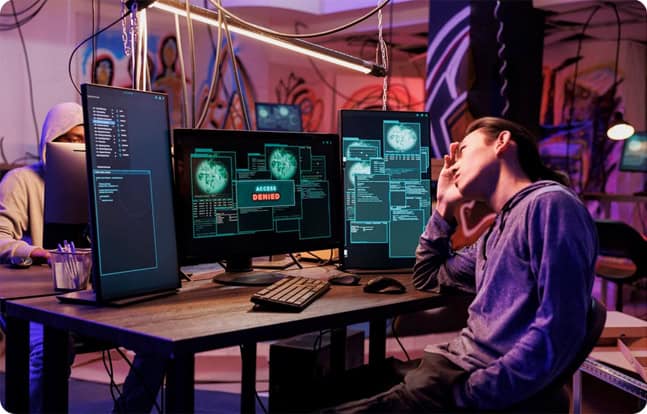
Online threats are becoming smarter, stealthier, and downright terrifying. If you work for a business, chances are you’ve seen that it’s not quite as easy to be safe online as it used to be. The cyber-criminals are advancing, and so too are the methods they employ. From artificially intelligent hackers to deepfaked scams that can trick your most vigilant worker, the dangers are on the rise and evolving quickly.
So, what exactly should businesses be looking out for in 2025? Let’s take a closer look at the greatest cybersecurity threats making headlines this year—and what you can do to be one step ahead.
1. Artificial Intelligence-Based Malware That Evolves With Time
Welcome to the era of smart malware. This is not your grandpa’s old computer virus that you sweep away with a scan. Today, cyber-criminals are employing the use of artificial intelligence and machine learning to create malware that can adapt on its own on the fly. This can evade traditional security systems, bypass firewalls, and dig deeply into your systems silently.
The most intimidating aspect? This malware can learn. It can learn to adapt, evade detection, and even learn when it’s being observed. That’s why conventional threat-hunting solutions simply don’t cut it anymore. Organizations are looking for advanced AI-based cybersecurity software that can pick up on anomalous behavior, rather than waiting for known signs.
2. Zero Trust Isn’t a Buzzword Any Longer
Cybersecurity used to be about erecting a large wall and keeping the bad people out. Let’s be real, though—the wall is gone. We now work from home, log on from coffeehouses, and leverage our personal devices. The perimeter is gone.
That’s why the concept of “Zero Trust” is gaining ground. Essentially, it’s, “Trust nobody and verify everything." Even if you are within the network, you must still prove you have permission to get what you are attempting to obtain. It’s like showing your credentials at every entrance. A little inconvenient? Yes. Necessary? Yes.
3. The Quantum Danger Could Be Nearer Than You Realize
Quantum computing is still science fiction-sounding, but it’s moving closer to being real. When it becomes mainstream, it may be able to crack the encryption that currently secures nearly everything online. That’s a big deal.
Cybercriminals already know this, and they are already stealing data now that’s been encrypted, to crack it when and if they ever get access to quantum tools. That’s why companies are now looking at “post-quantum” encryption, essentially, anticipating and getting ahead of quantum before it’s the new standard.
4. Ransomware-as-a-Service Is Booming
Once, you required a tremendous amount of coding ability to be able to launch a ransomware assault. Now? There are full-fledged services that make it possible for anyone—even an individual who knows nothing about technology—can rent out a ransomware package and initiate an attack for a cut of the proceeds.
This is a nightmare for businesses since it sets the bar for hackers. It’s never been easier for an attacker to encrypt your data and then demand an exorbitant price to release it. In response, more companies are using real-time, automated security and ensuring they’ve got clean, offline backups on standby if something goes wrong.
5. 5G and the Messy Reality of Edge Security
5G is fantastic for connectivity and speed, but it also invites a whole host of new woes for online privacy protection. With so much connected stuff at the “edge” of networks (smart sensors, health care devices, and the like), there’re more opportunities for things to go awry.
These devices can be hacked and employed as stepping stones into the broader networks. Businesses that don’t secure every aspect of their infrastructure, from the edge to the core, leave themselves wide open.
6. Insider Threats Worsening Because of Remote Work
Do you recall when you could simply walk over to a colleague’s desk and solve a problem? With hybrid and remote work here to stay, that’s less likely—and that makes insider threats more difficult to detect.
Most often, employees don’t intend to make a mess. Perhaps they post a link to a sensitive document unintentionally, or maybe a worker takes a laptop to a coffee shop and doesn’t close it. Occasionally, however, insiders may act out intentionally, stealing data, leaking information, or disrupting systems. Regardless, it’s up to businesses to have systems that monitor unusual behavior without being overbearing.
7. Supply Chain Attacks Are the Sneakiest of Them All
You may trust your security, but can you trust your vendors? That’s the catch about supply chain attacks. The hackers don’t always target the largest company—they target the little guy in the middle, the one who has lax security but immediate access to a larger target.
We’ve already witnessed large-scale breaches due to third-party service or software update compromise. It’s causing companies to focus way beyond their internal networks and start doing some real research on who they affiliate themselves with and what real security those associates provide.
8. Cloud Containers May Open the Wrong Doors
Containers and micro services are fantastic, they enable developers to move more quickly and create more agile apps. However, if you’re not keeping them secure, you may as well be inviting hackers into your virtual home.
One poorly configured container can provide an opening for the bad guys, and then it’s an easy hop to your primary systems. The trick is what people refer to as “shift-left” security: integrating security tests directly into your development lifecycle, as opposed to waiting until everything’s live.
9. Deepfakes Are Fooling More Than Just Your Eyes
Deepfakes are more than entertaining TikTok clips now. Crooks are using deepfake voice and video to impersonate executives or other authority figures. Picture receiving a video call from your CEO instructing you to move funds or provide sensitive data, and it looks and sounds identical to them!
Such a scam is difficult to detect in real time, particularly when individuals are accustomed to doing work remotely through video. Companies are now pushing back using more rigorous worker training and added verification procedures, such as double-verifying requests through varied channels.
10. IT and OT Are Colliding – And It’s Complicated
In the traditional view, your IT (email, your apps, your cloud applications) and your OT (your equipment, your factory control systems, your heating and cooling systems) existed in different worlds. No more. As businesses move online, and industries digitize, those distinctions are eroding. It poses new risks. A bad actor could breach an email system and bring a production line down. Or hijack a sensor at a factory and use it to launch an attack on a larger scale. Organizations must begin thinking about cybersecurity as one large picture, not individual silos.
Wrapping it All Up
So yes, cybersecurity in 2025 is not all about firewalls and antivirus software any longer. It’s an actual chess match, and the rules continually change. Businesses that wish to remain secure—and remain in business—must start thinking ahead, training staff, and refreshing tech.
You don’t have to be a security pro overnight though. Understanding what’s available, being mindful of the greatest threats, and being proactive before something occurs, however, is the sort of mindset that’ll be worth it in the long term.



